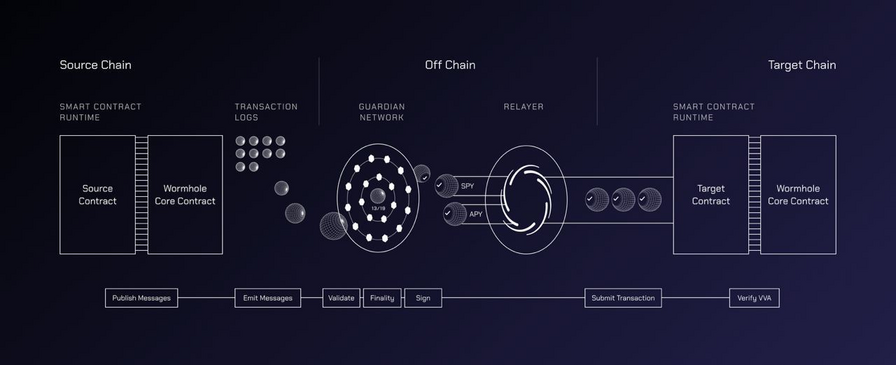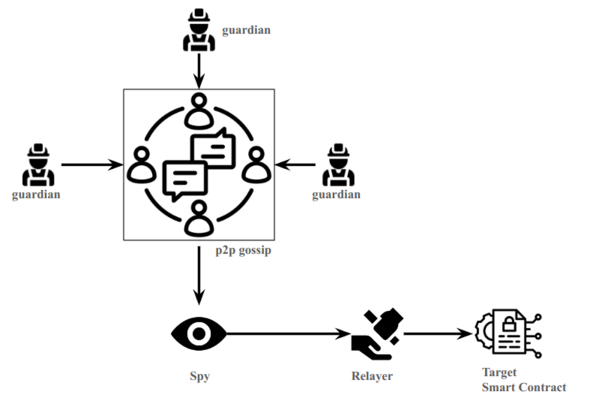Wormhole's Guardian Network DoS through p2p vulnerability
1. Introduction
We discovered a vulnerability within the p2p implementation of Wormhole that would have allowed an external attacker to crash the Guardian network. The attack was non-volumetric, easy to reproduce, but difficult to catch. The difficulty came from the fact it was a second-order attack, meaning the hacker attacks the victim, but the exploit would be triggered by the victim itself at a later stage.
Wormhole and Guardians
Wormhole uses a set of smart contracts in combination with a Guardian network to operate.

Guardians play a critical role for the functioning of Wormhole. As per the documentation:
Wormhole relies upon a set of distributed nodes that monitor the state on several blockchains. In Wormhole these nodes are referred to as Guardians. (…) It is the Guardian’s role to observe messages and sign the corresponding payloads. Each Guardian performs this step in isolation, later combining the resulting signatures with other Guardians as a final step.
Guardians combine their results by communicating with each other through a p2p gossip network (based on the library libp2p).
Each actor on the p2p network is identified by a PeerId, determined by a private key that the node has generated. Guardians send broadcast messages on the gossip network, meaning everyone will receive them. Other actors (Spies) can join the gossip network, and listen to the messages sent by the Guardians. Those messages can be:
- Verified Action Approvals (VAA)
- Observations
- Heartbeats
The primary role of the Spy is to catch the VAA and send them to Relayers, who will perform the interaction on the target chain.
Below is a schema that summarizes the different actors.

We identified 2 interesting behaviours of the gossip p2p network:
- Lack of access control: Not only Guardians can send messages. Anyone can send messages on gossip, even Spies, or any rogue client. Those messages will be interpreted by the Guardians.
- Lack of anti-replay mechanism: Anyone can replay Heartbeats: Guardians will not check if they have already received a message.
From here we tried to use these facts to see if we could crash the p2p network.
First attempt: High Cardinality Attack
With the previous information we tried to find attack vectors. The first promising one was High-Cardinality Attacks. You can check this vulnerability for reference. Those attacks occur when an external attacker can add lots of lines in the Prometheus metrics, increasing CPU/RAM consumption.
As mentioned here :
This can have implications for the performance and scalability of Prometheus, as each distinct label combination creates a separate time series in the system. A high cardinality can increase memory usage, CPU usage, longer query times, and higher storage requirements.
Because the information of the p2p PeerId is random (depends on a generated secret key), and because the information about the PeerId is added in the metrics when a message is replayed, an external attacker can perform the attack by replaying old messages with a rogue client, and regularly change his PeerId. Because each Guardian listens to the p2p, this would impact all Guardians at the same time.
To go into details in the code: In the p2p.go file, there is a Switch Case that deals with received messages by Guardians.
| |
If we take the example of GossipMessage_SignedHeartbeat :
| |
The function that will treat the Heartbeat is processSignedHeartbeat() :
| |
In the end, the function collectNodeMetrics(signerAddr, **from**, &h) will update the metrics, with the PeerId that was given by the attacker.
The actual sender (p2p node) is from, which is a PeerId defined by its private key. This information is never checked within the function to ensure the PeerId is legitimate, meaning checking if it matches the real PeerId of the guardian having sent the Heartbeat h.
An external attacker can therefore:
- Join the p2p network with a rogue client,
- Replays Heartbeats,
- Change their PeerId by recreating a secret key,
- Go back to Step 1
By doing so, this will add metrics and the table will grow in size (+150/200 lines in the metrics for each new PeerId) because the new PeerId will be associated with all the metrics (different blockchains, versions, etc). Also, because of the p2p infrastructure, the rogue messages will be treated by the others Guardians that did not send the message, amplifying the attack. This could theoretically lead to a Denial-of-Service by filling up the disk of guardian nodes.
We can see that cardinality attack is a concern for Wormhole in multiple places through the code, for example node/pkg/p2p/netmetrics.go:
| |
Or again in the node/pkg/processor/observation.go file :
| |
We were able to produce a PoC that we shared with the Wormhole team, but there were many issues:
- The test environment provided by Wormhole (Tilt) consumes a lot of CPU, making our test inconclusive according to the team,
- The attack was very slow, meaning it could have needed volume to succeed, which would have made it categorized as a “Volumetric attack”, which is out-of-scope,
- Our PoC was inefficient because it used a modified Spy.
- The Prometheus client library used by the guardian nodes does not store metrics on disk. A restart of a guardian node clears out the metrics.
Due to the above issues, they wanted a better PoC where they could see the Guardians failing at their task (not seeing Heartbeats or observations). After discussing, they sent us this file to monitor this part.
After analysis of this file, we realized that:
- It was unsure to be suited in our case, because it monitors Heartbeats while we mess up Heartbeats.
- It could be very useful for something else : it would allow us to write a better PoC for the vulnerability. Indeed, this file contains a “simple client” joining the gossip, while our tests were from a heavily modified Spy.
After having rewritten the PoC, we could see CPU/RAM consumption increasing, but nothing significant in a short period of time. Sometimes, we would see a Guardian restarting, we did not pay attention for a few days, this was actually the source of a bigger issue. We were so “focused” on the Cardinality Attack that we forgot to look at this “detail”. Typical mistake.
After having spent some time on this attack without success, we finally decided to look at why the Guardians would sometimes restart.
Second attempt: Timing attack leading to Second Order DoS
After having randomly reproduced a crash, we looked at the message:
| |
When a node sends a Heartbeat, there is this logic:
| |
Here is the function SetHeartbeat():
| |
On each Guardian, there is one v mapping per known Guardian, including one v mapping for himself.
The v mappings contain a list of associated: PeerId <-> Heartbeat
Also, before sending a Heartbeat, a Guardian checks that the v mapping for himself does not have more than 15 Heartbeats coming from more than 15 PeerIds. In case it fails, it reaches the panic.
This mapping is cleaned every minute with a Cleanup() function.
| |
This mapping is also updated when a Guardian receives a Heartbeat, where an attacker can add entries by replaying Heartbeats with a different PeerId.
| |
By replaying Heartbeats with different PeerId, our initial attack would fill the v mapping without us realizing it. Also, because of the cleanup mechanism that removes the structure every minute, the probability that we would trigger the crash was low but still existing.
It is however possible to crash the Guardians with proper timing.
The schema below describes the attack :

The steps are:
- Connecting 20 clients on the p2p with different PeerId.
- When a Heartbeat is received, we wait 10 seconds. Because the panic occurs when the Guardian wants to send Heartbeats, and because there is a cleanup mechanism, we are more efficient if we attack right before the next Heartbeat (which is every 15 seconds).
- Send 20 Heartbeats to the gossip from the 20 PeerId (1 Heartbeat per PeerId). This will pollute v to the limit (15 entries).
- When the Guardian wants to send its Heartbeat, it will cause a panic because v is full, and a restart of the Guardian will occur
Attack is:
- Not volumetric: A Heartbeat is around 1.7Kb. 20 Heartbeats (<40kb) to crash most Guardians,
- Easily repeatable,
- Fast to crash the Guardians (less than 2 minutes on our testbed)
- Impacts the bootstrap nodes: If the bootstrap nodes are down, other crashed nodes will not be able to join the network again
The attack was very successful. For n Guardians, we would crash n-1 Guardians in less than 2 minutes.
The code of the PoC can be found on Github
Here are some videos PoC with 4 Guardians, and the attack started from a Spy:
Crash of nodes bootstrap, 2 and 3 ; About the video:
- 0.00: Happy situation, all 4 Guardians receive Heartbeats from each other
- 0.36: Our attacker starts replaying Heartbeats
- 0.54: Crash of node 0
- 1.00: Crash of node 2
- 1.15: Crash of node 3
- 1.53: We filter to see which nodes crashed
Crash of nodes 1, 2 and 3 ; About the video:
- 0.00: Happy situation, all 4 Guardians receive Heartbeats from each other
- 0.38: Our attacker starts replaying Heartbeats
- 0.53: Crash of node 3
- 1.08: Crash of nodes 1 and 2
Conclusion
The issue was fixed in PR3873. When receiving a Heartbeat, the code now ensures that the PeerId of the p2p message matches the PeerId of the Guardian who generated the Heartbeat.
| |
In this case, the attack was difficult to catch because the vulnerability was of second-order: The attacker performs his action, but the vulnerability will be triggered when the impacted component performs a separate action. The Cleanup() function was also making the vulnerability more difficult to identify.
Beyond Wormhole, we have looked at p2p networks recently, and noticed that they are difficult to exploit :
- Attack surface is reduced: auditors will very often land in a “Switch case” logic, with a “default” case that ignores malformed messages,
- Messages are limited in size (2Kb in Wormhole’s case), reducing the possibility of creating payload,
- Frequently, rogue nodes cannot send valid messages because signature verification will be made, leaving us mostly with the possibility of replaying messages.
However, when a vulnerability is found on the p2p, it usually is of high impact because it will impact all nodes listening to the p2p. We have the strong conviction that whitehats are not done finding bugs in Blockchain p2p infrastructure.